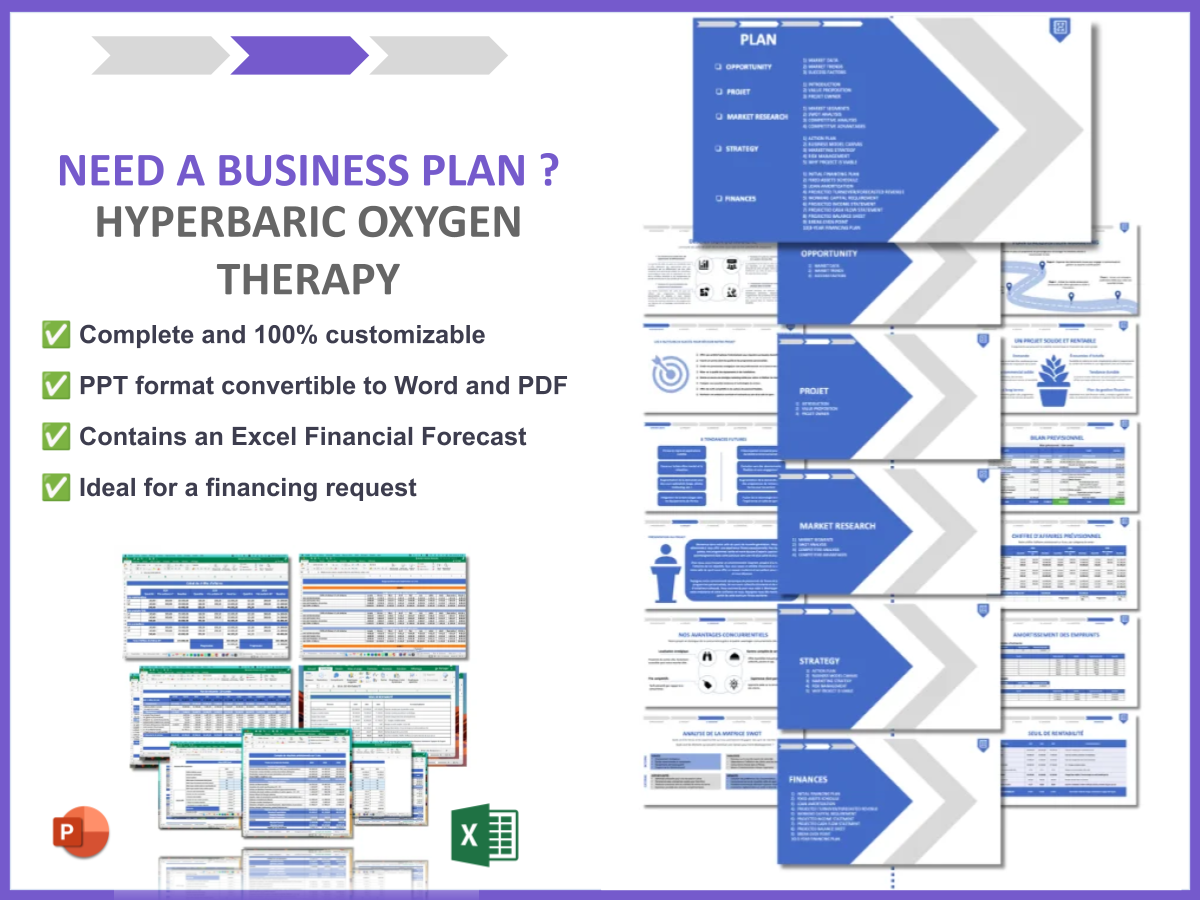Why Should You Have a SWOT Analysis for Hyperbaric Oxygen Therapy?
Imagine a world where healing is accelerated, and chronic ailments become a thing of the past. Hyperbaric Oxygen Therapy (HBOT) is making waves in the medical community, and understanding its landscape through a SWOT analysis is essential. This analysis can illuminate the path for practitioners and investors alike, helping them navigate the complexities of this rapidly evolving field.
Did you know that HBOT has been used to treat conditions ranging from diabetic wounds to carbon monoxide poisoning? It’s a powerful treatment that can enhance recovery, but it also comes with its own set of challenges. A comprehensive SWOT analysis allows stakeholders to evaluate the strengths, weaknesses, opportunities, and threats associated with hyperbaric therapy, ensuring informed decision-making.
Definition of Hyperbaric Oxygen Therapy: HBOT involves breathing pure oxygen in a pressurized environment, promoting healing and recovery in various medical conditions.
- Understanding the importance of SWOT analysis in HBOT.
- Defining strengths in the HBOT sector.
- Identifying weaknesses and how to address them.
- Exploring opportunities for growth in the HBOT market.
- Recognizing potential threats to HBOT practices.
- Ten real-world examples of SWOT analysis in HBOT.
- Practical tips for conducting your own SWOT analysis.
- Future trends in HBOT.
- The role of technology in enhancing HBOT services.
- Concluding thoughts on leveraging SWOT for success in HBOT.
How Do You Write a SWOT Analysis for Hyperbaric Oxygen Therapy?
Conducting a SWOT analysis involves a structured approach that breaks down the factors affecting Hyperbaric Oxygen Therapy. Let’s dive into its components to understand how to effectively analyze the landscape of HBOT.
Strengths
1. HBOT is known for its non-invasive nature, making it appealing for patients seeking alternatives to traditional treatments.
2. The therapy has a strong evidence base, supported by numerous studies demonstrating its efficacy in various medical conditions.
3. HBOT can be integrated with other treatments, enhancing overall patient care and outcomes.
4. Availability of skilled practitioners boosts the credibility and effectiveness of HBOT services.
Weaknesses
1. High operational costs can limit accessibility for some patients, making it a premium treatment option.
2. Limited insurance coverage may deter potential users from seeking HBOT.
3. Some practitioners lack adequate training in HBOT, which can lead to suboptimal patient outcomes.
4. Public awareness of the benefits of HBOT is still low, hindering its widespread adoption.
Opportunities
1. Growing interest in alternative therapies opens new markets for HBOT providers.
2. Increased research funding can lead to innovative applications of HBOT in treating various conditions.
3. Collaborations with hospitals and clinics can expand the reach and acceptance of HBOT.
4. Technological advancements can improve therapy efficiency and patient experience.
Threats
1. Competition from other emerging therapies can overshadow HBOT, making it crucial for providers to differentiate their services.
2. Regulatory challenges may impede practice expansion and the implementation of new protocols.
3. Misconceptions about HBOT can negatively affect public perception and acceptance.
4. Economic downturns may reduce patient spending on elective therapies, impacting HBOT practices.
SWOT Example N°1 for Hyperbaric Oxygen Therapy
This example illustrates how a local clinic implemented a SWOT analysis to identify its competitive edge in the market for Hyperbaric Oxygen Therapy (HBOT). The clinic aimed to assess its position and improve its services based on the findings from the analysis.
| SWOT | Analysis |
|---|---|
| Strengths | Experienced staff and state-of-the-art equipment. |
| Weaknesses | High treatment costs compared to competitors. |
| Opportunities | Increasing interest from sports medicine. |
| Threats | New entrants offering discounted services. |
Resume-Liste:
- Experienced professionals enhance service quality.
- High costs are a barrier for many patients.
- Sports medicine is a growing market.
- Competition is rising in the local area.
Conducting a SWOT analysis can reveal hidden strengths and weaknesses, guiding strategic decisions for the clinic in the competitive landscape of HBOT.
SWOT Example N°2 for Hyperbaric Oxygen Therapy
Here, we examine a hospital’s approach to integrating HBOT into its recovery programs. This SWOT analysis helped the hospital evaluate how best to implement Hyperbaric Oxygen Therapy as part of its comprehensive patient care strategy.
| SWOT | Analysis |
|---|---|
| Strengths | Comprehensive care approach with HBOT as a key component. |
| Weaknesses | Limited patient awareness of HBOT services. |
| Opportunities | Partnerships with rehabilitation centers. |
| Threats | Regulatory changes affecting therapy protocols. |
Resume-Liste:
- Comprehensive care enhances patient outcomes.
- Awareness campaigns are necessary to inform patients.
- Partnerships can broaden service offerings.
- Regulatory changes could impact operational procedures.
By understanding the SWOT factors, the hospital can position itself effectively in the market and maximize the benefits of Hyperbaric Oxygen Therapy.
SWOT Example N°3 for Hyperbaric Oxygen Therapy
This example focuses on a private practice specializing in Hyperbaric Oxygen Therapy (HBOT) for chronic conditions. The practice conducted a SWOT analysis to assess its market position and identify areas for improvement.
| SWOT | Analysis |
|---|---|
| Strengths | Specialized focus on chronic conditions. |
| Weaknesses | Limited resources for marketing. |
| Opportunities | Growing patient base seeking alternative treatments. |
| Threats | Increased scrutiny from insurance companies. |
Resume-Liste:
- Specialization attracts a dedicated patient demographic.
- Marketing efforts need to be bolstered to reach more patients.
- Alternative treatments are gaining popularity among consumers.
- Insurance challenges may limit patient access to HBOT.
Identifying these elements through a SWOT analysis can help the practice navigate challenges and capitalize on its strengths in the growing field of Hyperbaric Oxygen Therapy.
SWOT Example N°4 for Hyperbaric Oxygen Therapy
Explore how an HBOT startup analyzed its potential market entry. The startup utilized a SWOT analysis to evaluate its capabilities and identify its competitive advantages in the Hyperbaric Oxygen Therapy landscape.
| SWOT | Analysis |
|---|---|
| Strengths | Innovative technology sets it apart. |
| Weaknesses | Lack of brand recognition. |
| Opportunities | Emerging markets in developing countries. |
| Threats | Established competitors with loyal followings. |
Resume-Liste:
- Innovative technology can disrupt the market and attract attention.
- Building brand recognition will take time and strategic marketing.
- Developing countries offer new patient bases for HBOT.
- Established competitors pose significant challenges to market entry.
New entrants must leverage their strengths to overcome market barriers identified in their SWOT analysis and successfully establish themselves in the Hyperbaric Oxygen Therapy market.
SWOT Example N°5 for Hyperbaric Oxygen Therapy
This example highlights a well-established clinic that assesses its position in the market for Hyperbaric Oxygen Therapy (HBOT). The clinic conducted a SWOT analysis to identify its strengths and areas that need improvement to maintain its competitive edge.
| SWOT | Analysis |
|---|---|
| Strengths | Strong community ties and reputation. |
| Weaknesses | Aging equipment needs upgrades. |
| Opportunities | Growing awareness of HBOT benefits. |
| Threats | New regulations may impose additional costs. |
Resume-Liste:
- Community ties enhance trust and patient loyalty.
- Equipment upgrades are essential for maintaining quality.
- Public awareness is increasing, providing growth potential.
- Regulatory costs could impact profitability.
Understanding its SWOT can help the clinic maintain its competitive advantage while addressing weaknesses and seizing opportunities in the evolving field of Hyperbaric Oxygen Therapy.
SWOT Example N°6 for Hyperbaric Oxygen Therapy
This example examines a non-profit organization exploring the benefits of HBOT for underserved populations. The organization utilized a SWOT analysis to evaluate its capabilities and identify how to maximize its impact.
| SWOT | Analysis |
|---|---|
| Strengths | Mission-driven focus on community health. |
| Weaknesses | Dependence on donations for funding. |
| Opportunities | Grants available for health initiatives. |
| Threats | Economic downturns affecting donations. |
Resume-Liste:
- Community health focus builds strong relationships.
- Funding dependency may limit service expansion.
- Grants can support initiatives effectively.
- Economic fluctuations may jeopardize financial stability.
Non-profits must navigate funding challenges while maximizing impact through the insights gained from their SWOT analysis in the field of Hyperbaric Oxygen Therapy.
SWOT Example N°7 for Hyperbaric Oxygen Therapy
This example focuses on a research facility evaluating the potential for Hyperbaric Oxygen Therapy (HBOT) in treating neurological disorders. The facility utilized a SWOT analysis to assess its research capabilities and identify areas for growth.
| SWOT | Analysis |
|---|---|
| Strengths | Access to cutting-edge research and technology. |
| Weaknesses | Limited patient population for studies. |
| Opportunities | Collaborations with pharmaceutical companies. |
| Threats | Competition from other research institutions. |
Resume-Liste:
- Research access allows for innovative treatment exploration.
- Patient population limitations hinder study scope.
- Collaborations can enhance research funding and resources.
- Competition may impact funding opportunities and research output.
Strategic partnerships can amplify research efforts and outcomes, enabling the facility to leverage its strengths identified in the SWOT analysis for advancements in Hyperbaric Oxygen Therapy.
SWOT Example N°8 for Hyperbaric Oxygen Therapy
This example explores how a wellness center integrates HBOT into its holistic health offerings. The center conducted a SWOT analysis to identify its unique position in the wellness industry.
| SWOT | Analysis |
|---|---|
| Strengths | Holistic approach appeals to health-conscious consumers. |
| Weaknesses | High operational costs for maintaining equipment. |
| Opportunities | Growing wellness industry trends. |
| Threats | Market saturation from similar centers. |
Resume-Liste:
- Holistic offerings attract a dedicated clientele.
- Operational costs need to be managed carefully to maintain profitability.
- Wellness trends provide a fertile ground for growth.
- Competition from similar businesses requires differentiation.
Understanding its SWOT can help the wellness center carve out a niche in the growing market for Hyperbaric Oxygen Therapy and capitalize on emerging trends.
SWOT Example N°9 for Hyperbaric Oxygen Therapy
This example illustrates how a sports clinic assesses the application of Hyperbaric Oxygen Therapy (HBOT) for athletic recovery. The clinic utilized a SWOT analysis to evaluate its services and identify potential areas for enhancement.
| SWOT | Analysis |
|---|---|
| Strengths | Strong athlete client base and specialized services. |
| Weaknesses | Limited research on long-term effects of HBOT. |
| Opportunities | Expanding interest in sports recovery techniques. |
| Threats | Potential backlash from traditionalists in sports medicine. |
Resume-Liste:
- Athlete clientele provides a steady revenue stream.
- Research gaps must be addressed for credibility and trust.
- Interest in recovery techniques is on the rise among athletes.
- Traditionalists may resist new practices, impacting acceptance.
Leveraging strengths while addressing weaknesses is key for the clinic's success, as identified in their SWOT analysis of Hyperbaric Oxygen Therapy.
SWOT Example N°10 for Hyperbaric Oxygen Therapy
This example examines a telemedicine company exploring the integration of HBOT consultations. The company conducted a SWOT analysis to evaluate its capabilities and potential for growth in providing remote healthcare services.
| SWOT | Analysis |
|---|---|
| Strengths | Innovative telemedicine platform enhancing access to care. |
| Weaknesses | Limited access to physical HBOT facilities. |
| Opportunities | Increasing acceptance of telehealth solutions among patients. |
| Threats | Regulatory hurdles in telemedicine practices. |
Resume-Liste:
- Telemedicine enhances access to HBOT for patients in remote areas.
- Physical access remains a significant hurdle for comprehensive treatment.
- Telehealth acceptance is growing rapidly, creating new opportunities.
- Regulatory challenges need to be navigated carefully to ensure compliance.
Exploring telehealth opportunities can reshape service delivery, as highlighted in the company's SWOT analysis of Hyperbaric Oxygen Therapy.
Conclusion
In conclusion, conducting a SWOT analysis for Hyperbaric Oxygen Therapy (HBOT) provides invaluable insights into its market dynamics. By understanding the strengths, weaknesses, opportunities, and threats, practitioners and investors can make informed decisions that enhance their services and address challenges effectively. Whether you are starting a new clinic or integrating HBOT into existing services, a comprehensive SWOT analysis is your roadmap to success.
If you’re looking for a solid foundation to launch your business, consider exploring this business plan template for Hyperbaric Oxygen Therapy. Additionally, you can check out our articles on How to Set Up a Hyperbaric Oxygen Therapy Center? and How to Formulate a Hyperbaric Oxygen Therapy Marketing Plan? With Example to further guide your journey in this promising field.
Frequently Asked Questions
What is Hyperbaric Oxygen Therapy?
Hyperbaric Oxygen Therapy involves breathing pure oxygen in a pressurized chamber to promote healing and recovery from various medical conditions.
How does a SWOT analysis help businesses?
A SWOT analysis helps businesses identify their strengths, weaknesses, opportunities, and threats, enabling better strategic planning and decision-making.
Who can benefit from HBOT?
Individuals suffering from chronic wounds, sports injuries, and certain medical conditions may greatly benefit from Hyperbaric Oxygen Therapy.
Is Hyperbaric Oxygen Therapy safe for everyone?
While HBOT is generally safe when performed by trained professionals, it may not be suitable for everyone, particularly those with certain medical conditions.
What are the costs associated with Hyperbaric Oxygen Therapy?
The costs for HBOT can vary widely based on the location, facility, and insurance coverage options available to patients.
How can I find a reputable HBOT provider?
Look for certified clinics with experienced staff and positive reviews to ensure quality care in Hyperbaric Oxygen Therapy.
Can HBOT be used for sports recovery?
Yes, many athletes utilize HBOT to enhance recovery and improve performance following injuries.
What are the regulatory challenges for HBOT?
Regulatory challenges can differ by region and may affect how HBOT services are delivered and reimbursed.
What future trends are expected in Hyperbaric Oxygen Therapy?
Anticipate advancements in technology and increased integration of HBOT with other medical treatments as the field evolves.
How can I promote my Hyperbaric Oxygen Therapy business?
Implementing a well-structured marketing plan and utilizing various promotional strategies can effectively enhance visibility and attract clients to your HBOT services.







